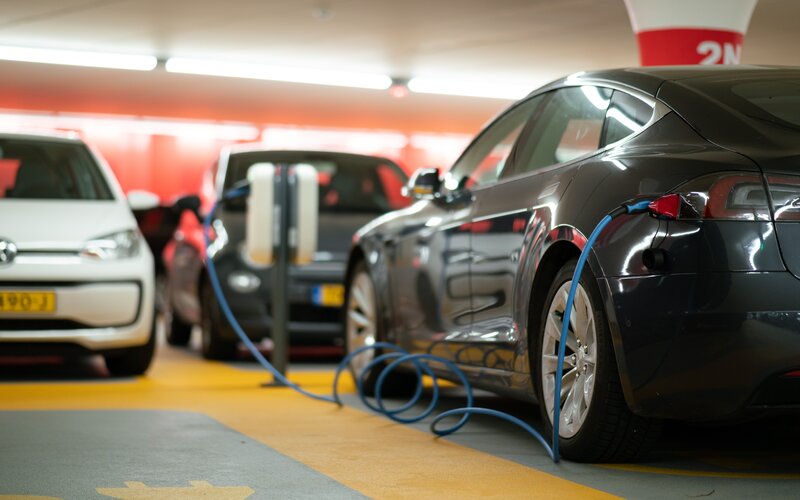Vehicle emission standards – also called fuel efficiency standards – are government-enforced requirements that restrict the amount of pollutant released by cars, trucks, and other vehicles. Typically, they demand car manufacturers ensure average emissions from new vehicles sold are limited to a certain level.
Australia doesn’t regulate vehicles’ carbon dioxide emissions right now, but legislation is in the works. Interestingly, much of the demand for such emission standards comes from the automotive industry itself.
Those arguing for vehicle emission standards believe they could drive down the cost of buying and owning electric cars in Australia.
Aussies are increasingly adopting electric vehicles
Australians are have doubled down on EVs in recent times. Nearly 9% of all cars sold down under last month were battery powered.
That marks an incredible jump from just 3.1% of sales over the whole of 2022, which was, in turn, a whopping leap from 0.49% of all sales in 2021, according to Federal Chamber of Automotive Industries (FCAI) data.
And we appear to have a favourite brand of EV. Surprise! Its Tesla.
The Elon Musk-headed brand accounted for 4.4% of all cars sold in Australia in June. In fact, the Tesla Model Y beat out the Ford Ranger as the nation’s second favourite car, behind the Toyota Hi-Lux.
But the broad popularity of Tesla in Australia is relatively new. In November 2022, it wasn’t even in the top 10 most popular car brands purchased. Though, Aussies have been quick to pick up Tesla keys since then.
And it could be just the beginning. More than half a million Australians are planning to buy an EV in the coming four years, with nearly 370,000 of those hoping to buy a Tesla.
Australia debates vehicle emission standards
Australia is one of the only developed nations without a fuel efficiency standard to manage emissions – a trait it shares with Russia. Cars make up nearly 10% of Australia’s carbon emissions, also known as greenhouse gas emissions.
As the nation has its sights on reaching net zero by 2050, it would make sense that questions regarding vehicle emissions are brought to the table. And that’s exactly what happened earlier this year. The Federal Government got to work designing future fuel efficiency standards, as part of a National Electric Vehicle Strategy, in April.
“This strategy offers an historic opportunity to develop fuel efficiency standards that learn from international best practice, while recognising the unique needs of Australians,” Minister for Infrastructure, Transport, Regional Development, and Local Government Catherine King said.
The government's proposed fuel efficiency standard is expected to be released by the end of this year following a consultation period.
“A strong standard will let us catch up to the rest of the developed world where we can finally embrace greener, cheaper, more efficient cars,” Electric Vehicle Council CEO Behyad Jafari said.
The nitty-gritty of proposed emission standards
Now, I’m sure some readers are keen to know just what limitations might be applied in Australian emission standards regulation. Unfortunately, those details are still being debated.
We do know that, under the standards, a car’s emissions will be measured by grams of carbon dioxide released per kilometre driven.
For reference, until 2024, the European Union’s targeted emissions will be:
-
Fewer than 95 grams of carbon dioxide per kilometre for cars.
-
Fewer than 147 grams of carbon dioxide per kilometre for vans.
Those targets will be cut by 15% from 2025 until 2029 and slashed to zero from 2035. It’s up to vehicle manufacturers to ensure their fleet’s average emissions are below targeted levels.
That’s notably more severe than the voluntary CO2 Emissions Standard developed by the FCAI for passenger cars and light SUVs in 2022:
-
Under 146 grams of carbon dioxide per kilometre travelled.
The FCAI’s standard is apparently an achievable target for Australia’s automotive industry.
The industry body assessed nearly 650,000 cars sold in Australia last year, finding they recorded an average of 131 grams per kilometre.
Could introducing emission standards lower the price of EVs?
If you’re one of the half-a-million Aussies considering buying an EV in the coming years, the introduction of fuel efficiency standards needn’t concern you.
They could, in fact, lower the price of EVs for consumers. That’s because vehicle manufacturers will have more incentive to ship more fuel-efficient vehicles here, increasing supply and (potentially) allowing them to charge lower prices.
However, it will likely take time for prices to noticeably fall.
In the short term, the price to buy new internal combustion engine (ICE) vehicles might increase on new emissions standards, but the amount of cash it takes keep them on the road will probably drop significantly. That’s according to research by Mandala, commissioned by the Electric Vehicle Council and the Climate Council.
It found the cost of buying a new ICE will likely rise 1.1% annually between now and 2027. That could increase by another 0.3% per year if emission standards come into play.
Meanwhile, the cost of purchasing a new EV is expected to fall by 2.8% annually over the coming years as competition heats up and the cost of batteries falls. The price of a new EV is expected to moderate at slightly more than the cost of a new ICE.
Still, because its far cheaper to run an EV, a buyer would likely make up the difference with two years.
The research also found that as EV prices come down, those of ICEs will likely fall as well in a bid to stay competitive.
The real savings that emissions standards will likely bring consumers will come in the form of lower running costs. Mandela estimates the average Aussie will save a total of $10,000 over the life of their car thanks to lower fuel and maintenance costs.
“It’s clear that a strong standard will improve the efficiency of new vehicles, increase the supply of electric vehicles, reduce CO2 emissions, bring health benefits by reducing air pollutants, and save motorists money,” Mr Jafari said.
How much does an EV cost in Australia?
If you’ve got your eye on a new EV, but you also need to be mindful of a budget, you’re in luck. Savings.com.au has compiled some of the cheapest EVs available for Australian buyers in 2023.
Those hoping to spend under $40,000 might turn to the BYS Dolphin or the MG 4 EV Excite, which start at $38,890 and $38,990 respectively.
Another buyer with a budget of $50,000 might find the MG ZS EV Essence or the BYD Atto 3 particularly attractive. The former retails for $48,990 drive away while the latter starts at $48,011.
On top of that, Aussies buying a new EV might find they benefit from government subsidies or rebates, depending on where they live.
Image by Michael Fousert on Unsplash



 Denise Raward
Denise Raward
 Harry O'Sullivan
Harry O'Sullivan

 Hanan Dervisevic
Hanan Dervisevic
 Harrison Astbury
Harrison Astbury

